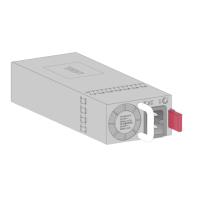4-6
Chassis Candidate physical IRF ports Use restrictions
S6520X-54HF-EI
S6520X-54HF-HI
• 48 × SFP+ ports on the front panel
• 6 × QSFP28 ports on the front
panel
• All physical ports to be bound to an
IRF logical interface must have the
same data rate.
• An SFP+ port can be used as an
IRF physical port only when it
operates in 10 Gbps.
• A QSFP28 port can be used as a
IRF physical port only when it
operates at 100 Gbps.
Planning the cabling scheme
Use the following cables to connect the IRF physical ports on the switch :
5G/2.5G/1000BASE-T, 10G/5G/2.5G/1000BASE-T, and 10G/5G/2.5G/1000/100BASE-T
autosensing Ethernet ports—For the available cables, see hardware information and
specifications for the switch series.
SFP+ ports—SFP+ transceiver modules and optical fibers or SFP+ cables. For the available
models, see hardware information and specifications for the switch series.
QSFP+ ports—QSFP+ transceiver modules and optical fibers or QSFP+ cables. For the
available models, see hardware information and specifications for the switch series.
SFP28 ports—SFP28 transceiver modules and optical fibers or SFP28 cables. For the
available models, see hardware information and specifications for the switch series.
QSFP28 ports—QSFP28 transceiver modules and optical fibers or QSFP28 cables. For the
available models, see hardware information and specifications for the switch series.
For a short-distance IRF connection in an equipment room, use a twisted
pair/SFP+/QSFP+/SFP28/QSFP28 cable.
For a long-distance IRF connection, use SFP+/QSFP+/SFP28/QSFP28 transceiver modules and
optical fibers.
The following subsections describe several H3C recommended IRF connection schemes by using
SFP+ cables and SFP+ transceiver modules and fibers. All these schemes use a ring topology.
these schemes, all physical IRF ports are located on the same side. If physical IRF ports are on
different sides, you must measure the distance between them to select an appropriate cable.
Connecting the IRF member switches in one rack
Connect the IRF member switches (9 switches in this example) in a rack as shown in Figure4-4. The
switches in the ring topology (see Figure4-5) are in the same order as connected in the rack.

